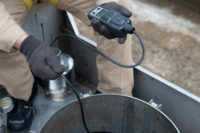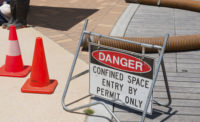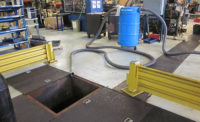Confined spaces such as tanks, containers and shafts represent a major danger. The good news is that you can significantly reduce the risks involved by understanding these environments and measuring air quality — before entering them. Here’s what you need to know.
Why do accidents happen in confined spaces?
Fatalities in confined spaces are most often the result of an atmosphere that is oxygen-deficient, toxic or combustible.1 According to the Bureau of Labor Statistics, 136 people in the United States died in accidents while working in confined spaces in 2015.2
For this reason, entering confined spaces requires very specific precautions. Many countries have strict regulations related to working in confined spaces. OSHA3 regulation 29 CFR 1910.1464 applies in the U.S.
This regulation includes the obligation to complete a risk assessment and create a work permit. Furthermore, supervisors and individuals working in confined spaces need to be thoroughly trained and certified. Approximately 200 people worldwide die each year as a result of an accident in a confined space.5 This begs the question: Why do so many accidents — some of them fatal — still happen? What goes wrong in these situations?
The answers are diverse. Sometimes, the lack of an adequate risk assessment means that the work location was not even classified as a confined space, so the hazards were not realized. After all, recognizing a tank as a possible confined space should be relatively easy. But what about bottlenecks and angles in larger, apparently less risky spaces? If a confined space is not recognized as such, the accompanying safety measures probably don’t exist.
Another typical cause is that while a risk assessment may have been performed, there was no valid work permit to provide information detailing the dangers that existed prior to entry. Or, the employee was not adequately trained for working in the confined space — but was nonetheless required to perform the task.
Hazard, danger and risk
To complete a risk assessment for specific work processes, it’s important to understand the difference between a “hazard”, a “danger” and a “risk.”
OSHA uses dictionary definitions of these terms. A “hazard” is something that can cause harm. A “risk” is the chance, high or low, that a hazard will actually cause somebody harm.
OSHA 1910.145 defines “danger” as a major hazard situation where an immediate hazard presents a threat of death or serious injury to employees.
Here’s an example. Acid that could cause chemical burns in the event of skin contact or inhalation has been stored in a tank. This represents a potential danger to the worker who is expected to enter the tank for maintenance work. However, the tank has been thoroughly purged and ventilated, which means that the probability, and therefore risk of skin and lung damage to the worker, is close to zero.
What is the purpose of a risk assessment?
The goal of a risk assessment is to list all of the dangers present at a particular work location and evaluate the scope of their risk. This includes measures that may be taken to help prevent, reduce or control dangers identified, as well as defining rescue scenarios.
Safety managers should also consult system and production plans for the evaluation process. These can provide specific references to structural features and potential dangers due to production residues. They should also think about specific work processes and anticipate possible risks – for example, the potential development of an explosive atmosphere by adding solvents to a sealing paint.
It is important to analyze step-by-step which person or persons could be threatened by a specific danger and which working methods and/ or personal protective equipment ensure safe entry and exit.
Before starting the work, all of the information resulting from the risk assessment must be documented and shared with the supervisor, safety guard, and relevant worker. The risk assessment should be regularly checked and updated as necessary – ideally within defined intervals, but at least once a year.
How can specific dangers be identified and risks assessed?
First, the safety manager needs to get an overview of the situation by asking the following questions: What is the container (tank, silo, etc.) used for? What hazardous substances does it contain? What type of hazardous substances are there – caustic, corrosive, radioactive? Is it extremely hot or cold inside? Is there a lack of oxygen or danger of explosion? Are there mechanical dangers, such as active hydraulic systems? Is there a danger of being engulfed by the contents of the container, such as a fine- grain granulate?
A rating model is useful for risk assessment. To create one, the safety manager should list all of the possible dangers to which people are exposed and the control mechanisms available. Next, the safety manager should assess the probability of each danger on a scale from 1 to 8.
After this, the safety manager should check control mechanisms in terms of effectiveness and expand them as needed.
Creating a safe work process
The conventional hierarchy of measures in occupational safety can help you create a safe work process. This involves specifying methods and procedures that need to be implemented at a practical level. The goal of a safe work system is to permanently minimize the risks of specific work processes.
A safe work process includes:
- Regulations for supervisors
- Appropriate training of all participants
- Access rules and obligatory gas measurement pre-tests
- Necessary tools and protective equipment
- Emergency plan
- Communication channels
- Continuous monitoring to ensure adherence to processes
An example of an effective way to permanently reduce risks when entering a confined space is selecting the correct gas measurement process, gas detection device, and matching sensor. The solution must be suitable for pre-entry measurement of the space regarding the specific toxic or explosive gases that normally occur there. The pre-entry measurement and detailed measurement results must be documented on the work permit.
Other requirements must be taken into consideration when selecting personal protective equipment, such as the suitability of the equipment for use in explosion-prone areas. The selection of respiratory protection requires knowledge of the necessary protection factor and the type of air supply.
It’s critical to understand that conditions inside a confined space can change during the work process. Therefore, it is essential to continuously monitor the atmosphere inside the space.
What is the function of the work permit?
Generally, the work permit is an important component of a safe work process and may be required by law or regulation. Work permits are essential for potentially dangerous work or any high-risk work that is not routine and does not form part of the production process. Such a permit formalizes and documents the communication between the plant management, supervisor, and relevant worker.
This is especially important when contractors perform work, since clear information makes communication easier. Finally, the permit must be integrated in the companyʼs internal monitoring and auditing system.
The work permit includes:
- Description, location, and environment of the work; warning of possible dangers
- Authorization rules and responsibilities of the issuer and recipient of the document
- Emergency plan
- Confirmation of training of the person who will perform the work (especially relevant if contractors are employed)
Work permits alone do not make confined-space entry work safer. It’s also imperative that the people who will perform the work understand all of the points indicated on the work permit and are adequately trained. For example, do they know which precautions to take and what equipment can save their lives?
Identifying hazards and professionally analyzing risks make it possible to choose the right solution to reduce or eliminate risks. The right training and workshops offer the necessary information, which can then be put into practice.
The information provided herein is for information purposes only and may not reflect real-world conditions. Please exercise professional judgment, as well as local, state, and federal regulations as to whether or not to use the information contained uin this article. Draeger, Inc. assumes no responsibility for the consequences of use of such information.
Sources:
- https://www.osha.gov/SLTC/confinedspaces/hazards_solutions.html
- https://www.bls.gov/news.release/cfoi.nr0.htm
- OSHA – Occupational Health and Safety Administration
- https://www.osha.gov/pls/oshaweb/owadisp.show_document?p_table=STANDARDS&p_id=9797
- http://www.hsimagazine.com/article.php?article_id=507
- http://www.healthresearchforaction.org/sph/occupational-health-and-safety-worker-hazards-confined-spaces



